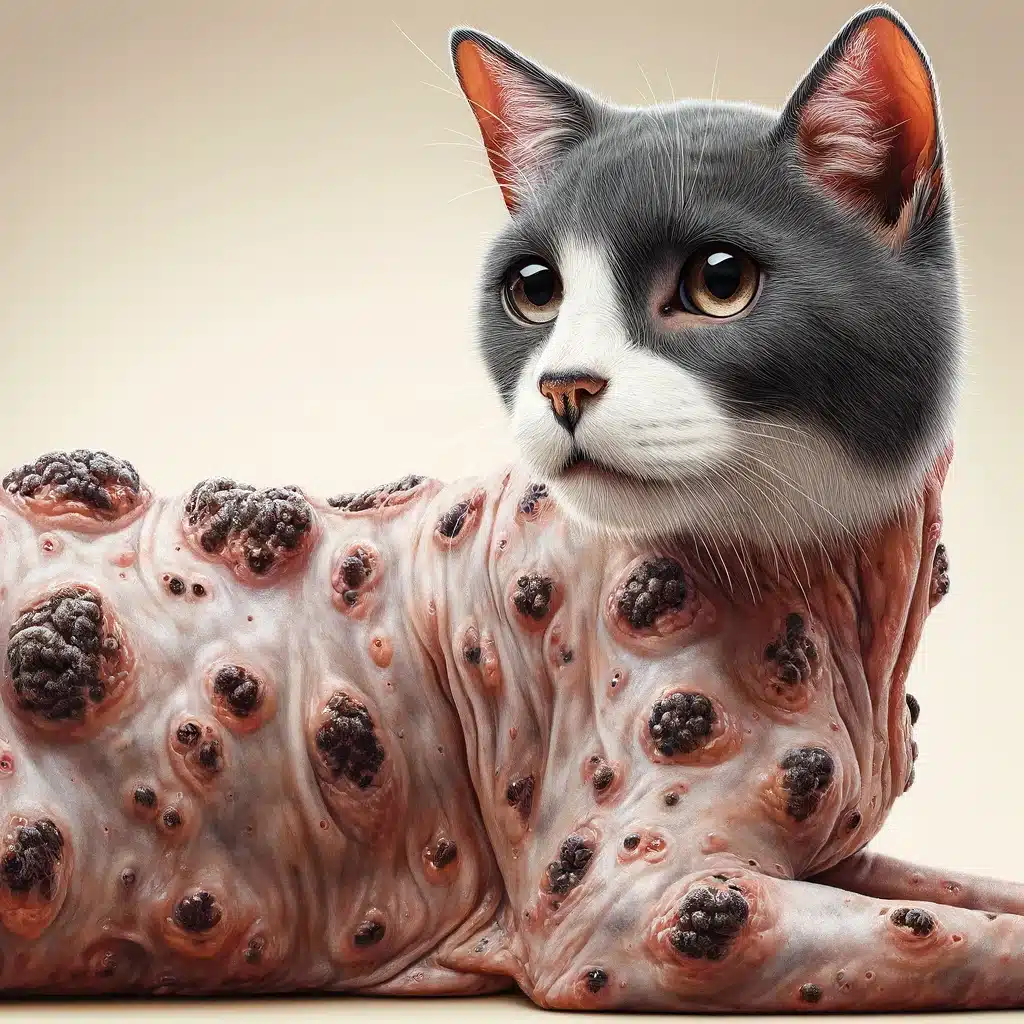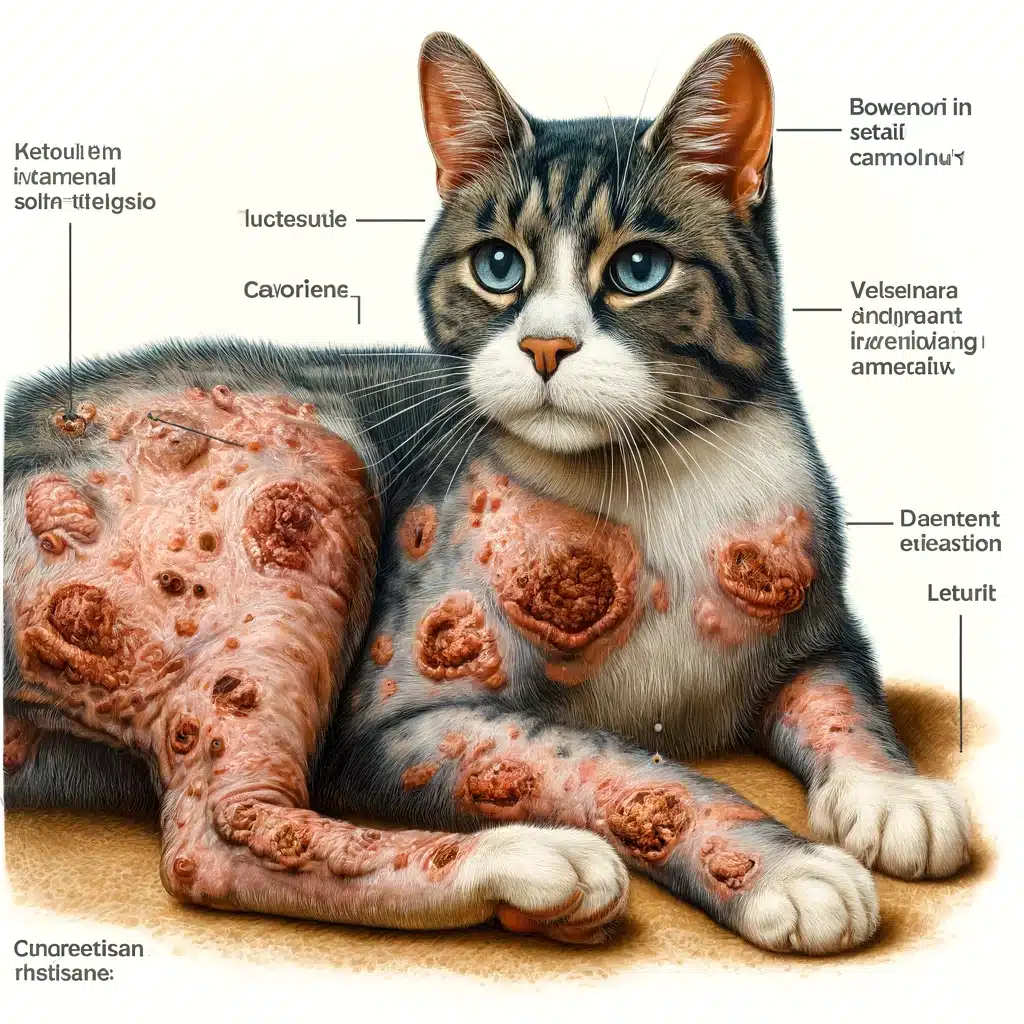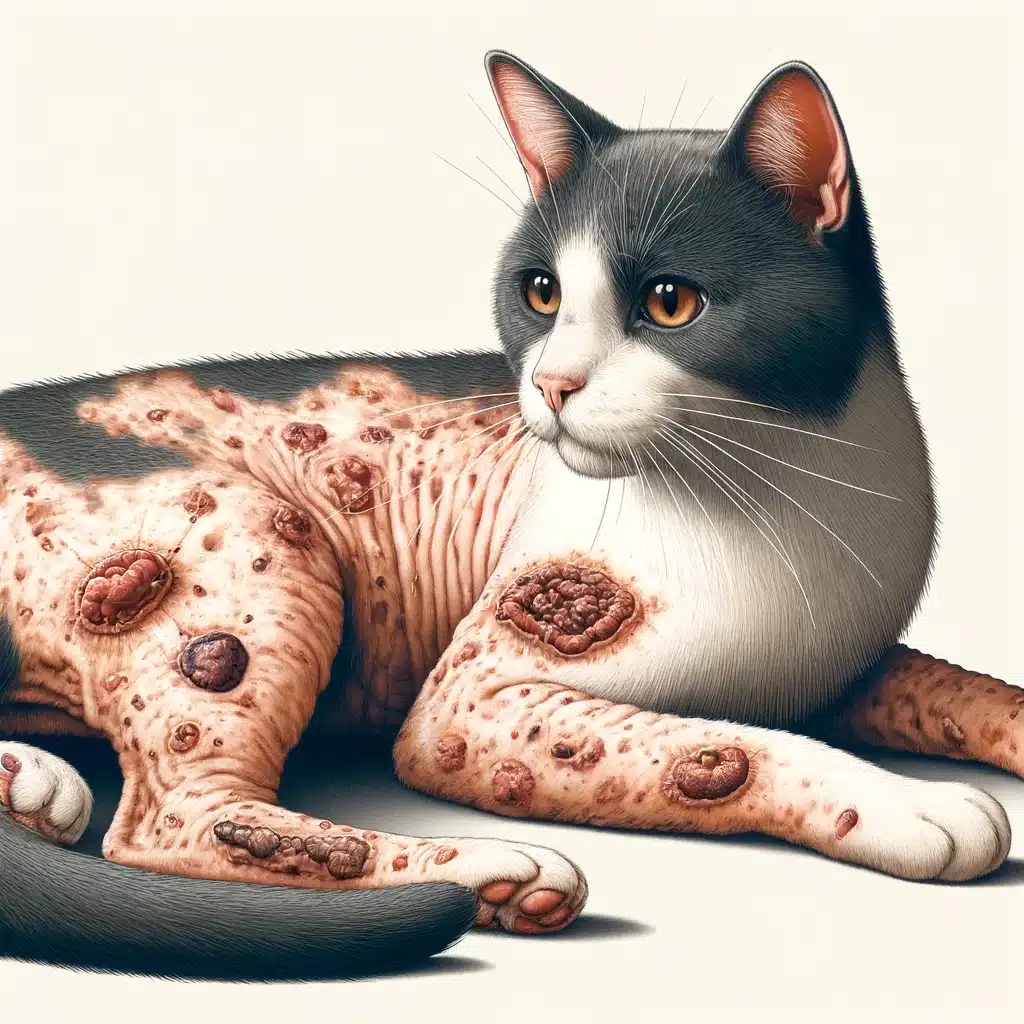- What is Bowenoid In Situ Carcinoma (BISC)?
- What symptoms do affected cats show?
- What is the risk of BISC?
- How is BISC diagnosed?
- How is BISC treated?
- Which breeds of cats are particularly often affected by BISC?
- What is BISC?
- Symptoms of BISC
- Treatment options
- Frequently asked questions (FAQs) about Bowenoid in situ carcinoma (BISC) in cats
- Prevention and long-term care of cats with BISC
- Recommendations for pet owners
- Summary Bowenoid in situ carcinoma (BISC)
What is Bowenoid In Situ Carcinoma (BISC)?
Bowenoid in situ carcinoma, or BISC, manifests as a rare neoplastic growth of the epidermis in older cats caused by papilloma viruses. This disease is characterized by neoplastic keratinocytes in the outermost layer of skin that do not penetrate the basement membrane and therefore do not penetrate the underlying dermis.

What symptoms do affected cats show?
Typically, one or more areas (about 0.5-3 cm in diameter) with dark pigmentation of the skin develop. These areas may be accompanied by scales and adherent dark crusts and are often asymmetrical. These changes are usually discovered when the cat is petted, as they are initially covered by fur and do not appear to be bothersome to the cat. The full extent of the lesions often only becomes visible after clipping and can cover a significant area.
Extended description of BISC symptoms
Skin color changes: One of the most noticeable symptoms of BISC is dark, pigmented patches on the skin. These can vary in size and color, from light brown to almost black.
Skin texture: In addition to the discoloration, you often notice a change in the texture of the skin in the affected areas. Scales and thick, dark crusts may form that adhere firmly to the skin. These texture changes are important indicators of the disease.
Asymmetric distribution: The affected areas are usually not symmetrically distributed and can occur on different parts of the body, often in places that are easy to miss during daily stroking.
Clinical inconspicuousness: Interestingly, many cats initially show no obvious signs of discomfort or pain in the affected areas. The lesions are often covered by hair, further concealing them and delaying detection.
Detection through grooming: Many owners only notice the symptoms when the cat's fur is trimmed or shaved for other reasons. After clipping, the full extent of the affected areas becomes visible and the lesions show their full size and distribution.
Spread: Without treatment, lesions can increase in size and spread over larger areas of the skin. This can cause the condition to worsen and make treatment more difficult.
It is important to emphasize that if there are any signs of these or other unusual skin changes, a visit to the vet is essential. Early detection and treatment are crucial to prevent the spread of the disease and ensure the cat's well-being.
What is the risk of BISC?
The sites affected by BISC may develop into a more invasive squamous cell carcinoma that breaks through the basement membrane and invades the dermis. Although this carcinoma often metastasizes late, it eats deeper into the skin and leads to bleeding, non-healing ulcerations that cause pain and are licked by the animal. Especially in exposed areas such as the head or paws, removal of the tumor can be difficult if it is not completely excised in a timely manner (with a healthy margin of 1-2 cm). In the later course, metastasis can occur, primarily to the lungs and regional lymph nodes.
How is BISC diagnosed?
Unfortunately, BISC is often diagnosed relatively late because the early stages are overlooked by pet owners or considered harmless. Due to the rarity of the disease, veterinarians do not always recognize the disease immediately. Sometimes there are already areas with a transition to invasive squamous epithelium. Diagnosis is made by histopathology of a skin biopsy taken.
How is BISC treated?
One treatment option is the use of imiquimod, a drug that activates the nonspecific and cellular immune system, leading to a strong inflammatory response and the death of tumor tissue. Although the cream is expensive, it must be applied regularly (2-3 times a week) over several weeks to months and must not be licked off. Side effects such as local skin redness and irritation, increased liver enzymes, blood count changes (neutropenia), loss of appetite and vomiting occurred in 40% of the treated cats.
Alternative treatment with CO2 laser
Alternatively, the changed superficial tissue can be removed under anesthesia with a CO2 laser. The CO2 laser can be used precisely to remove only the affected layer. The result is a wound that should heal within 2-4 weeks, during which the animal is not allowed to lick the area. The use of the CO2 laser offers several advantages: sealing blood and lymph vessels reduces bleeding and swelling, ensures clear vision during surgery, leaves a sterile wound bed and seals nerve endings, minimizing postoperative pain.
Unfortunately, there is currently no treatment that prevents new lesions from appearing. Therefore, new lesions need to be treated regularly, approximately every 6-12 months.
1. Topical treatment with Imiquimod cream: Imiquimod is an immunomodulating cream specifically designed to activate the cat's immune system. Application of this cream results in a strong local inflammatory response that attacks and destroys the abnormal tumor tissue. Treatment must be carried out consistently, often over several weeks or months, with the cream applied to the affected areas 2-3 times a week. It is important to ensure that the cat does not lick the cream. Possible side effects include skin irritation, local redness, increased liver enzymes, blood count changes, loss of appetite and vomiting.
2. Surgical excision: In cases where the lesions are clearly demarcated and not too extensive, surgical excision may be an effective option. The affected tissue is removed under general anesthesia. This is particularly worth considering in solitary or easily accessible lesions.
3. CO2 Laser Therapy : CO2 laser therapy is an advanced method of removing the affected skin layers. The laser enables very precise removal of the diseased tissue, minimizing the risk of bleeding and sealing blood and lymph vessels at the same time. This method offers the advantage of being less invasive and often results in faster healing and less pain after surgery. The treatment leaves a wound that resembles a first-degree burn and usually heals within two to four weeks.
Long-term care and follow-up: Regardless of the treatment method chosen, long-term monitoring and follow-up is crucial. Regular follow-up visits to the vet are necessary to ensure that no new lesions appear and that previous treatments have been successful. It is also important to continually check the cat's skin for changes and intervene early if necessary.
The choice of treatment depends on several factors, including the size and location of the lesions, the cat's general health, and the availability of treatment options. Your veterinarian will help you develop the best treatment strategy for your cat based on her specific case.
Which breeds of cats are particularly often affected by BISC?
Interestingly, there are no specific cat breeds that are considered particularly susceptible to Bowenoid in situ carcinoma (BISC). This disease can affect cats of different breeds. However, older cats appear to be affected more often, suggesting that age is more of a risk factor than breed.
It is important that cat owners of all breeds pay close attention to their pets' skin health and consult a veterinarian if any suspicious changes occur, such as unusual skin discoloration, crusting, or changes in the texture of the skin. Regular checks and early diagnostic measures can help prevent the development of more serious conditions and maintain your cat's quality of life.
Bowenoid in situ carcinoma (BISC) in cats
What is BISC?
Bowenoid carcinoma in situ is a skin disease caused by papillomavirus that primarily affects older cats and is characterized by tumorous keratinocytes in the epidermis without penetrating the basement membrane.

Overview of the typical BISC lesions on the skin of a cat.
Symptoms of BISC
The primary symptoms of BISC include dark, often asymmetrically distributed skin discolorations. These can be accompanied by scaling and crusty deposits, which are particularly noticeable when stroking.

Detailed presentation of the symptoms of BISC, including the dark, crusty lesions.
Treatment options
Imiquimod cream: Stimulates the immune system and causes a strong inflammatory response.
Surgical removal: Removes the lesions under general anesthesia.
CO2 laser therapy: enables precise removal of diseased skin layers.
Frequently asked questions (FAQs) about Bowenoid in situ carcinoma (BISC) in cats
How can I tell if my cat has Bowenoid carcinoma in situ?
To determine whether your cat has BISC, there are certain signs you should look out for. Typical symptoms include dark, pigmented patches on the skin, often accompanied by scales and thick crusts. These lesions are usually not symmetrically distributed and may initially be hidden by the cat's fur. Many cats show no obvious signs of discomfort, making early detection difficult. If you notice such changes, it is important to see a veterinarian who can make an accurate diagnosis through a skin biopsy.
What treatment options are there for BISC and how effective are they?
There are several treatment options available for BISC, which can vary depending on the severity and extent of the disease. These include topical application of imiquimod cream, which stimulates the immune system, surgical removal of isolated lesions, and CO2 laser therapy, which allows precise ablation of affected tissue. The effectiveness of these treatments can vary, but many cats respond well to therapy, especially if the disease is detected early. Long-term follow-up and regular check-ups are crucial to prevent recurrence.
Are there any preventive measures I can take to prevent BISC in my cat?
There are currently no direct preventive measures against BISC because the exact causes and risk factors other than age and viral infection are not fully known. The best prevention is to check your cat's skin regularly and react to any changes early. Good care and avoiding excessive sun exposure can also help minimize the risk of skin diseases. It is also important to have a regular veterinary check-up.
How long does BISC treatment take and what can I expect during it?
The duration of treatment for BISC may vary depending on the method chosen and the progression of the disease. Topical treatments such as imiquimod can last several weeks to months and require regular applications. Surgical procedures and CO2 laser therapy often offer quicker solutions but require adequate healing time and aftercare. During treatment, close collaboration with your veterinarian is necessary to monitor progress and address any side effects in a timely manner.
How does BISC affect my cat's quality of life and how can I support it?
BISC, if left untreated, can cause significant discomfort and pain. However, with timely and effective treatment, many of the negative effects can be avoided. To support your cat's quality of life, you should ensure that all veterinary instructions are followed closely and that your cat has a stress-free environment. Additionally, you should optimize your cat's diet and general care to strengthen its immune system. Regular loving attention and observation are also crucial to helping your cat through this time.
Prevention and long-term care of cats with BISC
Although there is currently no method to completely prevent recurrence of BISC lesions, careful monitoring of the cat's health is crucial. Regular veterinary exams can help detect and treat new lesions early. Additionally, it is advisable to regularly inspect the cat's skin for changes, especially after the fur has been trimmed.
Recommendations for pet owners
Pet owners should be vigilant and not ignore changes in their cats' skin. Early detection and treatment can make the difference in prognosis. It is also important to be present during treatment sessions with your veterinarian and to carefully follow all aftercare instructions to ensure your pet's well-being.
Summary Bowenoid in situ carcinoma (BISC)
Bowenoid in situ carcinoma (BISC) is a serious skin disease that occurs primarily in older cats. BISC is caused by the papilloma virus and manifests itself in the form of tumorous skin proliferations. These proliferations in BISC are localized in the top layer of skin, the epidermis, and do not break through the basement membrane. BISC is characterized by its tumorous keratinocytes located directly in the epidermis.
The symptoms of BISC are usually subtle and often only become apparent upon closer inspection. BISC manifests itself as dark, often asymmetrically distributed discoloration of the skin. These can be accompanied by flaking and adherent dark crusts. The changes caused by BISC are often hidden under the fur and are often discovered accidentally, for example when stroking the cat.
BISC can progress and lead to more serious skin conditions without appropriate treatment. The risk with BISC is that the in-situ lesions can develop into a more invasive squamous cell carcinoma that penetrates through the basement membrane into deeper layers of the skin and may even metastasize. Treatment of BISC is therefore crucial to prevent such progression.
BISC is often only diagnosed at an advanced stage because the early symptoms can be easily overlooked. The diagnosis of BISC is usually confirmed by biopsy and histopathological examination of the affected skin areas. This examination allows accurate determination of the stage of BISC and appropriate treatment planning.
The treatment of BISC involves various strategies depending on the severity and extent of the lesions. A common treatment method for BISC is the use of topical immunomodulators such as imiquimod, which trigger a strong inflammatory response in the affected areas and lead to the destruction of the tumorous cells. For more extensive or difficult to access lesions, surgical excision or the use of CO2 laser therapy may be necessary to effectively treat BISC.
The prognosis for cats with BISC can be good if the disease is detected and treated early. Regular follow-up visits are important to monitor and early address recurrence of BISC. Continuous observation and tailored treatment can help improve the quality of life of affected cats and control the spread of BISC.
Overall, the management of BISC requires a deep understanding of the disease and close collaboration between cat owners and veterinary professionals. With appropriate care and careful observation, the effects of BISC can be minimized and cats' health and well-being maintained.
Bowenoid in situ carcinoma, or BISC for short, represents a particular challenge in veterinary medicine. This disease, induced by the papilloma virus, primarily affects older cats and manifests itself through tumorous keratinocytes in the epidermis, the top layer of skin. BISC is characterized by its tendency not to penetrate deeper layers of skin such as the dermis, but remains a serious threat due to its potential to progress to more invasive forms of skin cancer.
Diagnosis of BISC is often delayed, which can complicate treatment. Symptoms are often hidden beneath the fur and include dark, crusty, and scaly skin lesions that are usually asymmetrically distributed. These symptoms are often discovered accidentally, usually by owners during routine care, making early detection difficult.
Treatment options for BISC are varied and depend on the stage of the disease. Topical immunomodulators such as imiquimod are a common treatment that stimulates the immune system, leading to a strong inflammatory response that can kill tumor tissue. For more advanced cases or difficult to access lesions, surgical removal may be necessary. CO2 laser therapy provides a precise method of removing affected layers of skin, minimizing the risk of bleeding and infection and promoting faster healing.
The prognosis for cats with BISC can be optimistic as long as the disease is detected and treated early. Regular monitoring and follow-up care are crucial to prevent recurrence of the disease. Affected cats require careful and ongoing care to maintain and improve their quality of life.
This understanding of BISC is critical for veterinarians and cat owners to make the best possible decisions for the health and well-being of affected animals. Early detection and choosing the right treatment strategy can help effectively control the progression of the disease and prevent it from spreading to other areas of the body.
Further sources:
